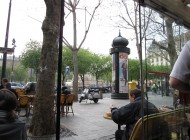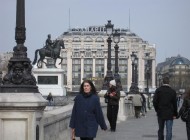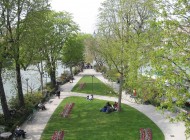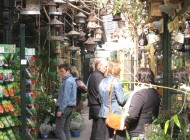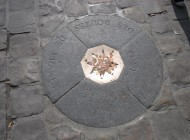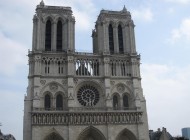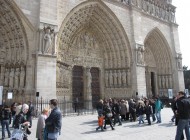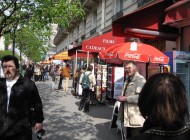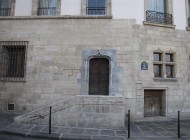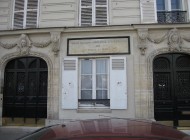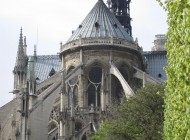We got up late today, like everyone around here it seems. Although, as Sandy pointed out, we actually have nothing specific to do so “late” is relative.
The usual annoyances at the gym, no one getting how to “work in” and leaving towels on one machine and reading for a while on another. Oh, well.
At the Café de la Mairie, we thought about not having a baguette at lunch, hard to do, at least here. I may have mentioned already this but a French writer, Georges Perec wrote a book about this café, at Place Saint-Sulpice, where he sat for 3 days and wrote what he observed. We thought we should do a 21st century version. For instance, saw the 96 bus stop, lady walking two French poodles, parked Vespa, etc. Best-seller, for sure.
Off we went for a 2+ hour walk, which I am about to condense and describe in 2+ minutes, around the Île de la Cité where the Celtic tribe known as the Parisii first settled in the 3rd century BC. From Pont Neuf, the oldest bridge in Paris, overlooking the square du Vert Gallant, past the Conciergerie, the royal palace before the Louvre and a prison during the Revolution, past the Palais de Justice and Sainte-Chapelle, onto rue de Lutèce with its flower stalls, into the lovely garden of the Hôtel Dieu, the 19th century hospital to Notre-Dame with its beautiful façade and portals (and a brass stud in the pavement, the Zero Point of Paris, from which the distance to all the other cities and towns in France are measured), by the cheesy tourist shops on rue d’Arcole, onto rue des Ursins where a modern French architect, Fernand Pouillon (1912-1986) built a medieval-looking home, along quai aux Fleurs where there’s a memorial plaque for the star-crossed lovers, Héloise and Abelard, to the back of Notre-Dame with its flying buttresses, essential for the large windows and a revolutionary architectural development of the time (13th century) into the sombre and affecting Mémorial des Martyrs de la Déportation, one corridor of which is embedded with 200,000 glass pearls for the 200,000 people that France deported during the Nazi occupation. There’s a quotation from St.-Exupery in the memorial which says,’There is no common measure between the freedom of combat and disappearance into the night.’
On the way back, despite the fact that Paris (especially on a somewhat sunny Saturday) seems much more crowded than we’ve noticed to date, we ran into our friend Charnois with whom we had already arranged to have dinner tonight at the superb Le Baratin (again). Un baratin is a smooth-talker.
Funnily enough, I ran into Charnois and some friends last October when we were here to celebrate his 75th birthday. Large city but small world or vice-versa.
- From inside Cafe de la Mairie.
- On Pont Neuf, the old department store, Samaritaine in the background.
- Square du Vert Galant from the bridge.
- Palais de Justice, Sainte-Chapelle is on the left.
- Flower stalls. We don’t know these people.
- Hotel-Dieu gardens.
- The Centre of Paris.
- Notre-Dame towers.
- Portals.
- Tourist shops on rue d’Arcole. We certainly don’t know that guy on the left who just finished browsing.
- Pouillon’s mock medieval house.
- Heloise and Abelard plaque and stone medallion.
- Back view of Notre-Dame with flying buttresses.
- Deportation Memorial Wall. (Ile St.-Louis is across the river.)
- Another view of Memorial, descending the stairs.
- At Le Baratin.
